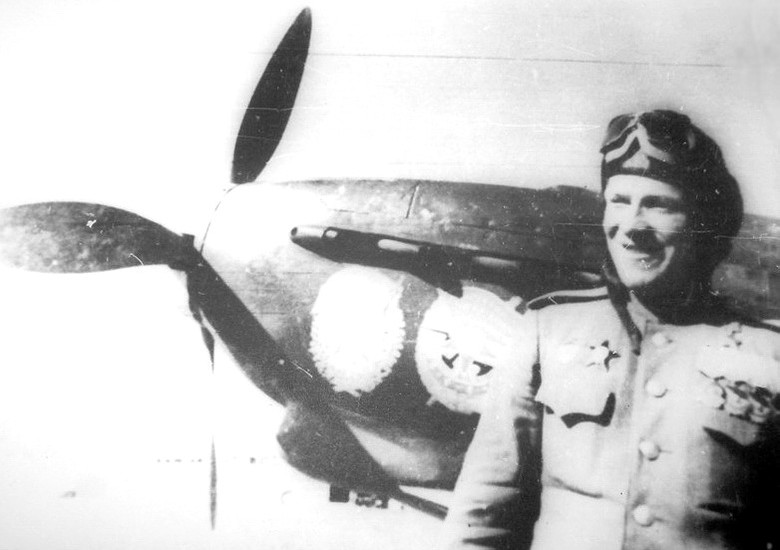Soviet Union

Major Stepan Gavrilovich Ivanov HSU
Soviet Union

Major Stepan Gavrilovich Ivanov HSU

| Date | Decoration | Note |
| 19/05/40 | Order of the Red Star | 1st |
| 07/11/41 | Order of the Red Banner | 1st |
| 14/02/43 | Order of the Red Banner | 2nd |
| 24/02/44 | Order of the Red Banner | 3rd |
| 22/08/44 | Gold Star of the Hero of the Soviet Union | |
| 22/08/44 | Order of Lenin | 1st |
| 13/06/52 | Order of the Red Star | 2nd |
| 22/02/55 | Order of the Red Banner | 4th |
| 30/12/56 | Order of the Red Banner | 5th |
| 16/10/57 | Order of Lenin | 2nd |
Stepan Ivanov was born in Taush on 20 March 1914.
He joined the Red Army in 1936 and graduated from Orenburg military aviation school in 1938.
Ivanov took part in the Soviet-Finnish Winter War in 1939-1940 where he served in 72 SmAP-SF, flying Polikarpov I-15bis.
In September 1941, Ivanov served in 152 IAP, flying Polikarpov I-153s.
152 IAP had been established in late 1939 within the 9th Army Air Force, being based initially at Voynitsa airfield near the town of Ukhta. 152 IAP, comprised of five eskadrilyas (two flying the I-15bis and three the I-153), played an active role in the “Winter War” with Finland between 9 January and 13 March 1940.
Following the cessation of hostilities, the regiment’s fighters operated from airfields in the Petrozavodsk, Leningrad and Arkhangelsk areas.
After the German invasion of the Soviet Union in June 1941, 152 IAP – with its five eskadrilyas equipped with 64 I-153s – became part of 134 IAD, within the city of Arkhangelsk’s air defence system. Based at Kegostrov airfield, it was engaged in the air defence of this vital seaport. In the absence of appropriate air observation, early warning and communication posts, there were no encounters with the enemy and, in any case, at that time the only Luftwaffe flights made in this area were by lone reconnaissance aircraft.
In August 1941, 152 IAP was reduced in size to just two squadrons operating 20 I-153s, its remaining three units being relinquished to allow them to serve as foundation squadron for newly formed regiments.
On 17 September, 152 IAP was transferred to Sosnovets airfield on the Karelian Front, from where it was to play an active role against enemy ground forces.
On 2 November, 152 IAP was pulled back to a rear area outside the city of Arkhangelsk to re-equip with Hawker Hurricanes.
Two weeks later, on 16 November, the regiment returned to the front with its first ten fighters.
After conversion to the Hurricane, 152 IAP became part| of 103 SAD (Combined Air Division), which had been formed within the Red Army Air Force on the Karelian Front at the end of October. The unit was based at the Segezhsk airfield complex and given the task of defending the southern sector of the Karelian Front, specifically the areas of Medvezhegorsk, Mosalsk and Rebolsk. The principal enemy in this sector was the Finnish Air Force.
On 4 December, a swarm of 3/LLv 28 was engaged in combat with three ‘I-18s’ over Maaselkä. Both parties lost one aircraft in a mid-air collision. Ylikersantti Pekka Vassinen participated in this fight:
At 13:00-13:05 hours. When we approached Maaselkä from south-west at 1,000 meters (I flew on the left wing and at the moment about 400m aside) I observed two (I-18s) climbing from below and behind in about 45 degrees angle, the enemy having considerable speed advantage still at our altitude. Kersantti Tomminen had also observed one I-18, which was shooting at ylikersantti Jussila from 100 metres behind. Kersantti Tomminen shot at the I-18 straight from the side getting hits behind the engine to the cockpit. The I-18 suddenly pulled up, when kersantti Tomminen hit the wing of the I-18 snapping it off. Kersantti Tomminen’s plane flipped on its back flying a while in this position and then the nose slowly sank into a vertical dive. A moment later, I saw the aircraft burning on the ground. I went to the surface, but did not observe any parachutes hovering. The aircraft shot by kersantti Tomminen crashed in flames. The climb rate of the I-18 was obviously good since a while earlier kersantti Tomminen had been to the surface without observing anything. The Russians opened fire from a relatively close range. My plane was MS-620.”Kersantti Toivo Tomminen flew Morane MS-329. Ylikersantti Oskari Jussila (MS-315) claimed a damaged ‘I-18’ in this combat.
“At 12:55-14:10 hours [Moscow time] three aircraft carried out the reconnaissance of enemy positions in the areas of railway junction No. 13, Medvezhegorsk, Par-guba, Kamselga, Kumsa and west of Pokrov. The mission was accomplished. The aircraft were then engaged in a combat two km south of Kriv with seven Heinkels and Me109s. The result of the battle was two enemy fighters shot down, additionally starshiy leitenant N. F. Repnikov rammed from straight ahead on one Me109, our pilot getting killed.”Though the regiment war diary states the enemy aircraft being Heinkels and Me 109s, in the claim list of 152 IAP these three appeared as Brewsters, one of which starshiy leitenant Vladimir Basov and starshiy leitenant Ivanov reported having claimed one each, while Repnikov was credited with the third in a “taran” ramming attack.
On 24 December, three SB bombers escorted by six Hurricanes from 152 IAP made a low-level attack on Tiiksjärvi air base. A patrol of LLv 14 was in the air and luutnantti Toivo Vuorinen reported:
“We attacked with three Fokkers from the sun against the 6-plane Hurricane patrol. One aircraft fired back. I shot at a Hurricane from 50 metres while it was making an upward turn. The aircraft went down to the surface pouring heavy smoke. Two aircraft fired from the right and ahead. I went down to the surface turning after the Hurricanes flying eastwards with greater speed, the distance increasing all the time. One aircraft was constantly smoking. I continued the chase to east of Rukajärvi.It doesn’t seem that luutnantti Vuorinen was credited with anything after this combat.
My plane was FR-105.”
In February 1942, he was posted away from 152 IAP.
In April 1942, he joined 769 IAP as a deputy eskadrilya CO, continuing flying Hurricanes with this unit.
In August 1942, he left 769 IAP and in October, he was posted to 910 IAP, flying Yakovlev fighters with this unit.
From December 1942, he served as an eskadrilya commander and later became deputy commander of the regiment.
On 10 January, kapitan Ivanov, returning from an intercept mission against enemy bombers in the Ilovlinskaya area, 85 kilometres northwest of Stalingrad, spotted a huge, four-engine aircraft flying at 2,500 meters altitude at a 270-degree heading. Approaching the strange “bird”, Ivanov identified the German crosses and opened fire obliquely from behind. The German gunners shot back at Ivanov, but soon their firing stopped, probably because they had been hit by the Yak-7B’s machine guns. The left inner engine of the Focke-Wulf FW 200 began to emit smoke.
Meanwhile, kapitan Nikolay Kozlov (Yak-1) and starshiy leitenant Boris Ivlev took off from 910 IAP’s airfield and were directed towards the FW 200 via radio. They arrived at the scene to see Ivanov carry out a diving attack against the enemy aircraft, opening fire at a distance of between 70 and 50 meters. Ivlev now attacked, and his bullets, fired at a range of 80 to 30 meters, started a fire in the cockpit and one of the right engines. Following repeated attacks against the huge and sturdy aircraft, the Focke-Wulf finally went into its final dive. Four men bailed out and opened their parachutes. The aircraft came down four kilometres east of the village of Ventsy (Ivanov and Ivlev reported the claim south-east of Kletskaya). The bodies of 32 men were found in the wreckage. Most of them were identified as officers that had escaped from Stalingrad.
This was FW 200 C-4 WNr. 151 (F8+HW) from KGrzbV 200 that crashed at Pitomnik while carrying wounded from Stalingrad. The aircraft was flown by Oberfeldwebel Eugen Reck, who became MiA together with his crew of wireless operator Feldwebel Kurt Manke, flight engineer Unteroffizier Fritz Elsenheimer, air gunner Obergefreiter Jakob Dahmen, air gunner Obergefreiter Heinz Engler and air gunner Unteroffizier Richard Schmidt.
On 9 October 1943, 910 IAP became a guard’s unit and was renamed 148 GIAP.
Ivanov was decorated with the Gold Star of the Hero of the Soviet Union on 22 August 1944. At the same time, he was awarded the Order of Lenin.
Major Ivanov ended the war with 1 biplane victory and a total of 10.
These had been claimed during around 500 missions and around 50 combats.
He continued to serve in the air force after the war and graduated from the Air Force Academy in 1951.
Polkovnik Ivanov was placed in the reserve in December 1959.
Ivanov passed away on 19 July 1983.
Claims:
| Kill no. | Date | Time | Number | Type | Result | Plane type | Serial no. | Locality | Unit |
| 1941 | |||||||||
| 1 | 04/10/41 | 1 | He 111 | Destroyed | I-153 | Lake Mash | 152 IAP | ||
| 2 | 04/12/41 | 12:55-14:10 | 1 | Brewster (a) | Destroyed | Hurricane | Maaselkä | 152 IAP | |
| 24/12/41 | 10:40 | 1/2 | Fokker D.XXI (b) | Shared destroyed | Hurricane | Tungut, Easter Karelian | 152 IAP | ||
| 1942 | |||||||||
| 3 | 09/04/42 | 1 | Bf 109 | Destroyed | Hurricane | Murmansk area | 769 IAP | ||
| 4 | 07/07/42 | 1 | Bf 109 | Destroyed | Hurricane | SW Murmansk | 769 IAP | ||
| 1943 | |||||||||
| 10/01/43 | 1/3 | FW 200 (c) | Shared destroyed | Yak-7B | SE Kletskaya | 910 IAP | |||
| 5 | 18/03/43 | 1 | Bf 109 | Destroyed | Yak-7B | S Kupyansk | 910 IAP | ||
| 6 | 29/03/43 | 1 | Ju 88 | Destroyed | Yak-7B | SW Kastornoye | 910 IAP | ||
| 7 | 29/04/43 | 1 | FW 190 | Destroyed | Yak-7B | NE Cheremisinovo | 910 IAP | ||
| 1944 | |||||||||
| 8 | 05/01/44 | 1 | Ju 88 | Destroyed | Yak-9 | NE Gatnoye | 148 GIAP | ||
| 9 | 10/02/44 | 1 | Ju 52/3m (d) | Destroyed | Yak-9 | Korsun-Shevchenkovskiy airfield | 148 GIAP | ||
| 10 | 28/03/44 | 1 | FW 190 | Destroyed | Yak-9 | S Zablot'ye Station | 148 GIAP | ||
| 25/04/44 | 1/2 | FW 190 | Shared destroyed | Yak-9 | N Geritz | 148 GIAP |
Biplane victories: 1 destroyed.
TOTAL: 10 and 3 shared destroyed.
(a) Claimed in combat with 3/LLv 28, which claimed 1 and 1 damaged ‘I-18’ while losing 1 MS.406 in a collision (pilot KIA). 152 IAP claimed 3 ‘Brewsters’ while losing 1 I-153 in a “taran” ramming attack (pilot KIA).
(b) Luutantti Esko Lehtonen (FR-150) of LLv 30 KiA.
(c) FW 200 C-4 WNr. 151 (F8+HW) from KGrzbV 200 shot down (crew POW).
(d) 1 Ju 52/3m from 10./TG 3 was lost in the region during the day due to unknown causes (crew KIA).
Sources:
All aces of Stalin 1936–1953 – Mikhail Bykov, 2014
Soviet Aces 1936-1953
Black Cross/Red Star Volume 4 Stalingrad to Kuban - Christer Bergström, 2019 Vaktel Förlag, Eskilstuna, ISBN 978-91-88441-21-8
Deutsche Luftwaffe Losses & Claims -series - Michael Balss
Soviet Hurricane Aces of World War 2 – Yuriy Rybin, 2012 Osprey Publishing Limited, Oxford, ISBN 978-1-84908-741-1
Suomen Ilmavoimat part III – 1941 – Kalevi Keskinen and Kari Stenman, 2007, ISBN 978-952-99743-1-3


